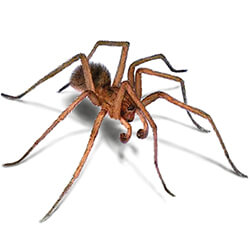Identification
- Colour Varies between species
- Size From 3 mm to 35 mm long depending on the species.
- Description All spiders have four pairs of legs, which are segmented and in most cases skinny in appearance.

How to spot a spider
Despite being remarkably varied in appearance, spiders share a number of common characteristics that make basic identification easy. Most notably, all spiders have four pairs of legs, which are segmented and in most cases skinny in appearance. Unlike insects, which are comprised of three distinct body segments, spiders are arachnids and have unregimented bodies with two main divisions. The front portion called the cephalothorax, which is a fusion of the head and thorax, includes the spider’s eyes, mouth, fangs, poison glands, and stomach. The legs also attach to this area. The bulbous rear portion, which comprises the abdomen, houses vital organs and is essential to silk-spinning and mating. Most spiders found in Canada range from 3 to 8 mm in length, with males remaining much smaller in size than females.
Problems caused by spiders
In rare instances, some species of spiders will bite humans. Bites typically result from the victim putting on a shoe or piece of clothing with a spider trapped inside. The widow spider (Latrodectus spp.) is the only spider found in Canada that can be hazardous to humans. Contrary to popular belief, black widow spider bites rarely result in death. Symptoms depend on the bite area, victim sensitivity, and amount of venom injected. The neurotoxins in the venom of the black widow affect the nervous system and may result in muscle cramps, sweating, headache, and high blood pressure. If left untreated, the bite site can become seriously infected. However, black widow spiders are not very common in Canada.
Aside from physical harm, spiders can cause psychological distress to individuals with arachnophobia. The sight of spiders can also affect the aesthetic of a home or building, as webs and crawling pests are unsightly. Though more of a nuisance than a hazard, the presence of spiders often strikes people as intolerable and worthy of eradication.
Why do I have spiders
Common spiders found in Canada include the wolf spider, fishing spider, cellar spider, house spider, garden spiders and jumping spiders.
All spiders prefer dark, moist environments and tend to avoid contact with other organisms. In nature, they make homes in caves, tree hollows and shrubs, under rocks, and in soil.
In homes and businesses, spiders tend to build webs in basements, garages, and corners of rooms, gaining entry through cracks and crevices in the building.
Spiders lead solitary lives and prey on other pests, such as aphids, caterpillars, and various insects. Most live for about a year, while some can live as long 15 years.
How worried should I be about spiders
In rare instances, some species of spiders will bite humans.
Bites typically result from the victim putting on a shoe or piece of clothing with a spider trapped inside. The widow spider (Latrodectus spp.) is the only spider found in Canada that can be hazardous to humans.
Contrary to popular belief, black widow spider bites rarely result in death. Symptoms depend on the bite area, victim sensitivity, and amount of venom injected. The neurotoxins in the venom of the black widow affect the nervous system and may result in muscle cramps, sweating, headache, and high blood pressure. If left untreated, the bite site can become seriously infected. However, black widow spiders are not very common in Canada.
Aside from physical harm, spiders can cause psychological distress to individuals with arachnophobia. The sight of spiders can also affect the aesthetic of a home or building, as webs and crawling pests are unsightly. Though more of a nuisance than a hazard, the presence of spiders often strikes people as intolerable and worthy of eradication.
How can I prevent spiders invading
As spiders primarily enter the home through gaps and openings around the residence, homeowners should keep windows and doors closed and properly sealed, and caulk any gaps in foundational walls.
Keeping the residence clean and free from insects will also discourage spiders from entering by forcing them to look elsewhere for food sources.
The frequent removal of webs also curbs spider infestations. Most spiders in the home prefer dark, moist environments, such as basements. Dehumidifiers may make the habitat less appealing to the pests, while removing clutter will cut down on the amount of hiding spaces spiders can take advantage of.
Continually finding excess numbers of spiders in the home may signal a serious infestation issue requiring the services of a pest control specialist.
Types of Spiders
100% Satisfaction or Money Back Guarantee
Resolving your pest problem is our #1 priority. If re-treatment is required, we'll provide immediate services at no extra cost. If your expectations are not met, we guarantee a full refund of your service payment.
Remove pests from your home, and stop them from coming back
We work hard to listen, understand and assess your unique situation. Request a free, no-obligation estimate today for a customized pest program that fits your needs.
Request a Free Home EstimateRequest a Free Business Consultation

